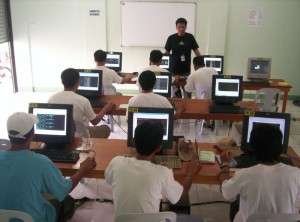What Are The Factors That Influence Learning?

Do you have to teach your employees new things? Is your training effective? One important element of instructional design is to take into account how the whole body learns or how learning is not “all in your head”. How do people learn? What are the factors that influence learning?
There are Many Factors Influencing Learning
There are a number of the factors that influence an individuals learning like movement, repetition, feedback, stress, and emotions. Learning is not all in your head. It takes place throughout your entire body. All of your senses are deeply involved in the process of learning. In fact, you cannot separate your senses from learning.
Use Your Entire Body to Learn
After all, how would you learn anything if you were not using any of your senses: sight, sound, touch, smell, or taste. You would have no inputs to your learning process. So, how does the entire body learn?
The entire body, including the brain, learns through movement and repetition but learning can be altered by stress and emotions. Movement is needed to engage the brain while repetition is used to move the information into your long term memory. Stress needs to be minimized as you learn while your emotions need to be tuned to learning.
Make Enough Time to Learn
Most people can learn at an “A” level if they are given enough time and appropriate instruction. Therefore, the problem with training is time.
In business we do not have the luxury of spending a lot of time. We usually only have hours to deliver days worth of material. People need to pick up the concepts quickly. The question is how can we speed up the learning process? The answer is in understanding how people learn in the first place.
People learn in a variety of ways but there are three main factors that influence the speed at which you learn anything new: aptitude (IQ), prerequisite knowledge and the quality of instruction.
Start with the Right Aptitude
The most often used measure of aptitude is Intelligence Quotient or IQ. An average person would be defined as having an IQ of 100. A person with a high IQ means that they have above average intelligence. In training this translates into the ability to grasp new ideas and concepts quickly.
So, the more high IQ students you have in a class the easier it is for the teacher. That’s because high IQ students can quickly fill in the “training gaps” on their own and teach themselves.
I am sure you have experienced such “training gaps”. It’s when the teacher is presenting concepts and you feel like they have not been fully explained the concept. You start to feel lost and then you drift away while in class.
High IQ students may drift off also but the difference is they understand the concepts and may be getting bored. The problem is high IQ students actually make it harder for everyone else. The teacher needs to fix the “training gaps” so that everyone can learn quickly. We can’t and don’t have companies of all high IQ employees. So, we can’t design classes with “training gaps”.
Build Prerequisite Knowledge
The other way people learn quicker is by having prerequisite knowledge of the subject. Prerequisite knowledge is the extent to which you already possess the foundation for the material you are attempting to learn. Schools do this all the time by breaking up the learning into multiple classes that build on each other.
For example, if you want to take our ISO Internal Auditor course then you would need to complete the online ISO 9001 foundation class first. The foundation class discusses what ISO 9001 quality standards are all about.
By ensuring that everyone has read and understands the ISO 9001 standard then the class can cover the rest of the auditor material a lot faster since we know that everyone has at least a basic understanding of ISO compliance.
Both aptitude and prerequisite knowledge are student characteristics and many times we don’t have control over these two variables. Employees have operational functions to complete and cannot spend too much time in training. But we do have a lot of control of the last factor – quality of instruction. In fact, we have total, 100% control over our own instructional quality.
Physical Movement
Our body’s senses provide a continuous stream of data to the brain, which we use to make decisions about the environment around us. The thoughts we produce will be expressed back through the very same senses we used to collect information from in the first place: speaking, creating music, or typing on a computer to record your thoughts.
When your hands are active, your brain is more engaged. Therefore, “hands-on” learning — drawing, playing games, acting out an experience — activates the brain. The brain needs movement to keep it focused on the task of learning.
Constant Repetition
A famous study on retention of textbook materials compared the percentage of material remembered after different intervals of time. The results:
|
Time Interval
|
% Remembered
|
% Forgotten
|
|---|---|---|
| After 1 day |
54%
|
46%
|
| After 7 days |
35%
|
65%
|
| After 14 days |
21%
|
79%
|
| After 21 days |
18%
|
82%
|
| After 28 days |
19%
|
81%
|
| After 63 days |
17%
|
83%
|
In another study on recall after listening to a lecture, students forgot more than 90% of the material after 14 days! Remembering what you’ve heard in lectures is even more difficult, because you’re not able to slow down, pause, or reflect on what you’ve heard.
Lectures Alone are not Effective
Lecturing does not provide for effective training. This is why when becoming a marketing major, it’s crucial to get in the field experience to solidify that knowledge. If lots of time passes without using, students are at risk of losing their hard earned knowledge all together.
Memory Fades
To overcome the natural “fading” effect of short-term memory, you must recall and repeat what you want to remember. With each repetition, the brain moves the information into longer term portions of memory, so repetition is definitely one of the factors that influence learning. The process of recalling over increasing intervals of time is called spaced repetition.
People with different IQs have similar spaced repetition recall patterns. For example, if you learn a foreign word, you will need to repeat it within 10 minutes, then 24 hours, and again within 5-7 days to ensure 95% retention. And then again, 25-30 days later and again within six months. After a few repetitions like this, you are on your way to storing information for recall for years.
Student Feedback
Feedback is one of the critical factors that influence learning and is also the main factor in creating controlled procedures. The learning loop and PDCA discusses feedback as the primary driver of improvement.
People are more likely to continue what they are doing if they receive positive feedback. Conversely, too much negative feedback will cause people to stop. When learning a new task, people need constant positive reinforcement to overcome the failures introduced along the path of learning.
Stress and Emotions
Stress caused by some type of physical or emotional trauma produces a hormone called cortisol that disrupts the connections between brain cells in the learning and memory part of the brain. Too much stress literally “shuts down” the brain and stops the learning process cold.
Emotions are just as critical to learning. They influence our attention, meaning, and memory. If you are angry, sad, upset, worried, or silly, what do you think your learning performance would be? Now compare that to being happy, energetic, enthusiastic, or serious.
People perform better when they are happier so performance in class discussions, tests, or exercises improves. Stress and emotions are factors that influence learning both positively or negatively, depending on the level of stress or emotion encountered.
Quality of Instruction and Learning
When talking about the quality of instruction we want to go beyond the basic principles of course design:
- Break course into instructional units.
- Define the learning objectives for each unit.
- Determine how students will demonstrate mastery of the learning objectives for a unit prior to beginning the next unit.
Course Design Affects Learning
All courses must exhibit the basic principles of course design. Learning is not all in your head. Learning takes place throughout your entire body. To be effective, instructors must design their classes to take into account how the whole body learns.
It should include movement and repetition and we can’t let stress or emotions run wild. The idea is to design your training units with 15 minutes of lecture followed by a 40 minute interactive exercise.
Interactive Lectures Increase Learning
Alternatively, you could have interactive lectures of up to 50 minutes provided they engage the audience with questions, discussions, and other interactive methods. But remember, don’t let people sit motionless and stare at a PowerPoint presentation for an hour. The average adult attention span is about 15 minutes, after that it becomes hard to follow new material easily.
Breaks Help Learning
Breaks of 5-10 minutes should be taken after every unit, followed by a review of what you just learned. If the training is over multiple days then review the past material each day the following morning. Review all of the important points at the end of the training program. Ideally we should review again after one week and then one month to ensure it sticks in long-term memory.
Training designed with these points in mind will keep the students involved, with information retained, and with increasing performance for years to come.
Factors That Influence Learning
Learning takes place throughout your entire body. All of your senses are deeply involved in the process of learning, so there are many factors that influence learning.
The entire body learns through movement and repetition but can be altered by stress and emotions. Training units should be designed with highly interactive lectures, multiple breaks, and reviews at increasing time intervals.
Want to see how it works? Attend the next ISO 9001 Internal Auditor training class to find out.
















Thank you Chris for this incredible piece of work. I am empowered by reading it.
does learning bring a permanent change in an organism.?
Maybe, but if you don’t use what was learned often, you might forget it and then it is unclear if there is any change.
Hi,
I found this article quite helpful for my studies in higher education. Can I cite this article for my reference? If no please let me know! If yes, could you help me with the name of author and the year of publication please?
Grateful,
Rituparna
The author is Chris Anderson, Bizmanualz Inc., originally published in 2008 and updated in 2019.